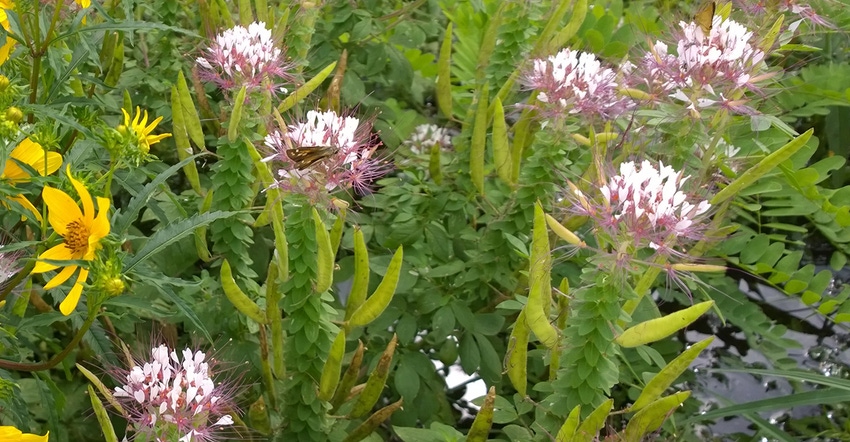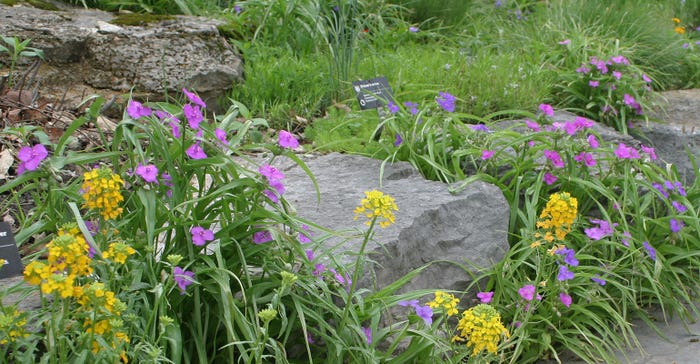February 16, 2018

Annual plants sprout from a seed, grow and die in the same growing season. With an abundance of native perennials to choose from, native annuals are sometimes overlooked — but they add prolific blooms to the garden.
Red-whisker clammyweed is a native annual that blooms for two to three months in late summer. It has rose-pink to white petals, and red stamens that are longer than the petals and look like red whiskers. The flowers are hummingbird moth and skipper magnets. Plants grow 18 to 24 inches tall and fit in tiny gardens. This annual wildflower is also one of those native plants that grows in the most inhospitable of habitats — gravel bars — so it grows well in most gardens.
Palafox looks like pink baby’s breath. Snow-on-the-mountain has stunning white and green floral bracts. Blue waxweed has tiny magenta flowers and purple fall color. Each of these late-summer- to fall-blooming annuals tolerates dry or rocky soils, and also grows well in most sunny gardens. They look great in flower with fruiting beautyberry, aromatic aster, native grasses and long-blooming star coreopsis.
Replanting for endurance
I think of some perennials as performing more like annuals for various reasons.
Rose verbena is perennial when growing in the wild, but is gone in a few years in most gardens. The same is true of cardinal flower, so replant them every few years — as we do with annuals.

ACCENTUATES ROCKS: The western wallflower (it's the yellow flower shown) is a great addition to any rock garden. It actually prefers the harsh landscape.

Blazing stars are by no stretch of the imagination annual, but we replant them every year or two because voles eat their corms constantly.
Black-eyed Susan is a short-lived perennial or biennial (living two years) in most landscapes, but it sometimes grows and dies in the same season like an annual. Plant it in spring to add more color for visitors and nectar for pollinators. In nature, these plants are typically yellow, but occasionally they’re red and yellow.
The western wallflower, an annual that grows wild on rocky glades, provides nectar for swallowtail butterflies. In gardens, it prefers average to dry soils and is easy to grow. Like all the annuals mentioned here, this one will spread slightly in the garden from seed.
Making annuals work
There is a trick to having success with annuals. It’s easy to buy new plants to replace old ones every year, but trickier to keep them going season after season.
If you mulch in February and March, you may smother seedlings that try to come up in April — especially if you mulch too thoroughly and deeply (a half-inch or more). If you wait until April to mulch, however, you may get a crop of unwanted weeds. I’ve found that it’s better to spread mulch 2 inches deep where you don’t want annual wildflowers, but thinner or not at all in areas where you do want them.
Ground leaf mulch is best because it is loose and porous. Targeted mulch spreading in February and March gives you some control; however, seedlings have a way of coming up where they want no matter what you do. This gives the garden a more naturalistic look.
Another way to encourage germination is to sow seeds on loosened bare soil in fall and mark their location with a tag, keeping mulch and leaves off these areas. In April, seedlings will emerge, and you can either leave them be, thin them if too dense, or transplant them to other parts of the garden.
If you want more color in your garden to enjoy and more nectar for wildlife, native annuals are the way to go, especially if you are gardening in containers. Keeping them going from year to year is not rocket science, and it can add enjoyment to your spring routine.
Woodbury is curator of the Whitmire Wildflower Garden at Shaw Nature Reserve in Gray Summit, Mo., and an adviser to the Missouri Prairie Foundation’s Grow Native! program.
About the Author(s)
You May Also Like




